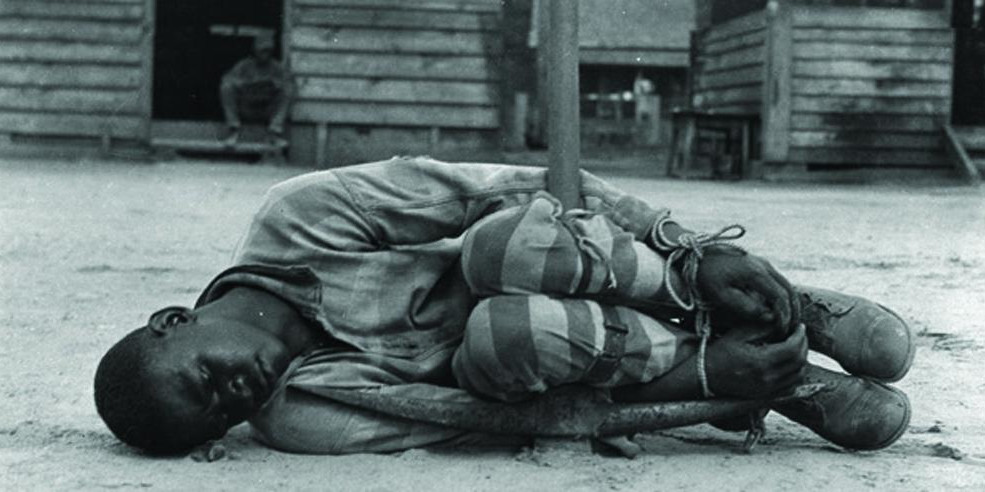American Prison
-
www.penguinrandomhouse.com/books/553182/american-prison-by-shane-bauer/9780735223585
-
different-kind-of-slavery-1541748013339.jpg
An imprisoned black boy punished at a Georgia convict camp, 1932.Credit: John L. Spivack. Fair use.Reviews
Please sign in or register to add your own review.
A gut-wrenching investigation into prisons and profitsI’ve long believed in the importance of undercover journalism. As a German, I’m familiar with the work of Günter Wallraff whose riveting report from the inside of Germany’s best-selling tabloid beats Manufacturing Consent any day when it comes to showcasing viscerally how propaganda works under capitalism. But America has had its share of undercover reporting icons, too — from Nellie Bly to Barbara Ehrenreich.
Shane Bauer continues this tradition with American Prison: A Reporter’s Undercover Journey into the Business of Punishment. Bauer (a Mother Jones reporter and former prisoner of the Iranian regime) spent 4 months as a guard at Winn Correctional Center in Louisiana, a for-profit prison. His book is a re-telling of this experience, interwoven with brief chapters about the history of incarceration and forced labour in the United States.

An imprisoned black boy punished at a Georgia convict camp, 1932. (Credit: John L. Spivak. Fair use.)After the US Civil War, former slaveholders hijacked criminal law to continue “slavery by another name” as Douglas Blackmon put it, with the same profit motives and the same racist ideology serving as pretext. African-Americans were rounded up, often on false pretenses like “vagrancy” or made-up charges, and put to work under the most horrific conditions imaginable.
Bauer explains that the death rates in this late 19th century prison-industrial complex rivaled and exceeded those of Soviet gulags during their worst years. For many of the predominantly African-American convicts, the emancipation of slaves had turned out to be pure fiction—instead, now the corporations “leasing” them didn’t even have any purely financial incentive to keep them alive.
It would take cases of white people like Martin Tabert to force modest reforms. Tabert was arrested on a trivial charge and leased to a lumber company. There, he was brutalized and killed by an overseer. The sheriff who had arrested him was paid a reward for every able body delivered into the hands of the company.
With the rise of mass incarceration in the late 20th century—the new Jim Crow—corporations once again began to see opportunities to derive profit from the caging and exploitation of human beings.
The Winn Report
Bauer’s experience as a Correctional Officer at Winn offers a window into a very different prison system. Here, the goal is not so much to force prisoners to build railroads or harvest timber. It’s to warehouse prisoners at the lowest possible cost, with the greatest possible profit.
The system Bauer describes is one of a chronically under-staffed facility with chronically under-paid and chronically under-qualified staff, where prisoners (when they’re not in segregation) live in open dormitories that house dozens of men. The guards barely manage to keep order.
Literally dozens of shanks—improvised weapons—are discovered routinely; stabbings are frequent and far more common than in publicly run facilities. A thriving underground economy of drugs, phones and sex involves both guards and inmates. The only thing that keeps the whole place from completely falling apart are irregular interventions by “Special Operations” teams from other locations, who attempt pacification by way of pepper spray.
Bauer describes the psychological toll this system takes on him. He (uncritically, which is disappointing) cites the Stanford Prison Experiment, and notes his own changes in behavior—from attempting to form relationships with some inmates, to taking pleasure in acts of revenge against others.
Ultimately, he performs well by the standard of the prison, and is put on the path towards a promotion before he resigns.
The Verdict
American Prison can be difficult to read, given that the entire book is about violence and coercion. There is nothing cathartic here: things haven’t gotten better since the book was published, and the private prison industry is thriving on efforts to cage men, women and children for attempting to seek shelter from brutality and destitution in their home countries.
But it is precisely this kind of reporting that is needed to show—beyond the power of an argument—why the idea of entrusting profit-driven corporations with incarceration is batshit insane.
As a chronicler of this insanity and its historical precursors, Bauer is meticulous. He distinguishes quotes that he was able to capture on audio from those he had to recollect. He provides extensive citations. He identifies the people who gave him permission to use his name. He includes the voices of those who disagree with him. He received appreciation from many of his former colleagues for his reporting.
And that’s precisely the standard that undercover journalism must live up to—especially in a country where garbage-spewing flimflam artists like James O’Keefe have given the genre a bad name.
Bauer is not first and foremost a scholar but a storyteller, and the historical review is relevant and accurate but patchy. Nonetheless, American Prison is a compelling and necessary book. 4.5 points, rounded up.
